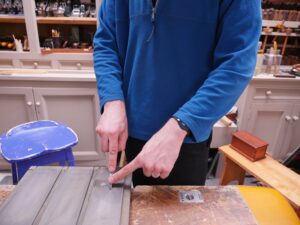Sharpening
Quick Links:
If you are a beginner, the sharpening section from our beginner site, Common Woodworking, may be useful to you:
At which angle should I sharpen?
How do you sharpen chisels for mortising?
It can vary from chisel to chisel depending on the steel as well as on the wood being used. Try it at 30 and if the edge isn’t fracturing too readily stay with it. If it is fracturing more than you would like you can sharpen for a few strokes at about 35 to make the edge stronger. It is a matter of sharpening to task.
Which glass cleaner do you use?
The glass cleaner that we use is auto glass cleaner rather than house window cleaner. The reason we use this is that it has non corrosive properties to stop the stones rusting as well as staying on the stones a bit longer than water. This helps to float off the swarf better which is another purpose of lapping fluid. Window cleaner has soap and fragrance in it which we don’t really want as well as, in our experience, causing or at least not stopping the stones from rusting. You can just use water, but we feel there are enough advantages to using glass wash.
You can also use a water additive that makes the water non-corrosive.
Which sharpening stones do you recommend?
For sharpening stones, we use 3″ x 8″ stones in 250 (coarse), 600 (fine) and 1200 (superfine) grit. We get them from Eze-Lap but you can also get them from DMT (although we have not tested the longevity of these):
Double sided
There is also the option to get 8″ x 3″ double sided 250 & 1200 grit stones as a cheaper or more portable solution, although they can be more awkward to use when sharpening everyday.
Using abrasive paper
There is also this alternative temporary solution to get you going:
Oil stones
The other option if funds are limited, is to use a double sided oil stone which has a coarse/medium side and a fine side. This isn’t as wide as the other stones, so it can be a bit tricky to sharpen plane blades, particularly wider ones.
This doesn’t sharpen to as fine a level as a fine diamond stone, but you may be able to get to a similar level spending more time on the strop. But you can often find them second hand or from a relative. They don’t stay flat, so can’t be used for flattening surfaces, but that isn’t an issue for daily edge sharpening.
Hollow stones: do they need to be flat?
What is the best height for a sharpening surface?
One key aspect is to make sure that the bench/surface that you’re sharpening on is low enough to get your upper body over, otherwise it can strain your body and it can be hard to apply the required pressure.
I keep on sharpening out of square/skewing the edge. Can you help?
Body Position
Have you seen our video on sharpening the plane? It is worth looking at for body position tips:
Paul keeps his shoulder square to the bench, with his iron/chisel in line with his right hand and arm. This hand controls the angle at the cutting edge with the index finger on the iron. The left hand then comes in at a right angle and applies more downward pressure.
If you try and sharpen straight on, you either twist your wrist and reduce your control on the angle of the blade, or it can be harder to keep you body in line without twisting it whilst applying sufficient downward pressure. That being said, this is not set in stone, more a good place to start. The main thing is that you are getting a sharp edge at the required angle.
Applying uneven pressure
You may be applying pressure to one side more than the other. That is very normal as you tend to favour your dominant hand. You can use a guide to help get you back on track, but the best thing is to move the fingers of your left or non dominant hand which is applying more downward pressure to the side where you want to take more off. You can keep an eye on whether it is being corrected using a square and by seeing how much of a burr is being formed on the side that you want to remove more stock.
I am skewing my narrow chisels/blade. What am I doing wrong?
When sharpening narrow chisels, it is more difficult to avoid skewing the edge. With practice, it can be done, but one thing you can try is to carefully sharpen with the chisel directly in line with the stones, rather than the 45 degree we usually recommend. It’s best to move your whole body inline to do this, rather than just twist your arms. Here is a pictures to help illustrate this.


I am gradually increasing my bevel angle. What can I do to avoid this?
One thing we commonly see with students is that they lift slightly to get a burr. Even if this is just a little bit, it can cause an increase of angle. People also tend to rock their iron to get the camber. This can lead to the same issue. This camber can be purposefully exaggerated by taking more off at the heel. Paul actually makes a point of spending extra time on the heel whenever he sharpens. He calls it constant maintenance mode. However, when working the edge, you want to only camber as much as the extension of your arms creates. This should help you not to increase the angle.
Putting your body in the same position at the same bench, and therefore height, helps to lock into that same angle. Look at Paul’s hand and body position to see what he does as a starting point.

